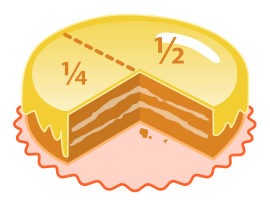User:Melchoir/Sandbox/Addition
Two rational numbers can be added together to get another rational number. In practice, rational addition is defined and carried out in terms of fractions:
It is straightforward to prove that the above operation is well-defined as an operation on rational numbers, in that it respects equivalence of fractions. It is compatible with the simpler addition operation on the integers. Rational addition also possesses the usual properties expected of a well-behaved addition operation: associativity, commutativity, and the existence of an additive identity and additive inverses.
The concrete task of adding together two fractions is notoriously difficult to teach when it arises in primary education.
Methods
[edit]Like fractions
[edit]The first rule of addition is that only like quantities can be added; for example, various quantities of quarters. Unlike quantities, such as adding thirds to quarters, must first be converted to like quantities as described below: Imagine a pocket containing two quarters, and another pocket containing three quarters; in total, there are five quarters. Since four quarters is equivalent to one (dollar), this can be represented as follows:
- .

Unlike fractions
[edit]To add fractions containing unlike quantities (e.g. quarters and thirds), it is necessary to convert all amounts to like quantities. It is easy to work out the type of fraction to convert to; simply multiply together the two denominators (bottom number) of each fraction.
For adding quarters to thirds, both types of fraction are converted to (twelfths).
Consider adding the following two quantities:
First, convert into twelfths by multiplying both the numerator and denominator by three: . Note that is equivalent to 1, which shows that is equivalent to the resulting
Secondly, convert into twelfths by multiplying both the numerator and denominator by four: . Note that is equivalent to 1, which shows that is equivalent to the resulting
Now it can be seen that:
is equivalent to:
This method always works, but sometimes there is a smaller denominator that can be used (a least common denominator). For example, to add and the denominator 48 can be used (the product of 4 and 12), but the smaller denominator 12 may also be used, being the least common multiple of 4 and 12.
References
[edit]- Brase, G.L. (2002). ""Bugs" built into the system: An evolutionary explanation for developmental difficulties in learning about fractions" (PDF). Learning and Individual Differences. 12 (4): 391–409. doi:10.1016/S1041-6080(02)00048-1.
- Malara N.A. (2003). "From Fractions to Rational Numbers in their Structure: Constructive Classroom episodes concerning operations and ordering" (PDF). In Rogers L. & Novotna J. (eds.) (ed.). Theory, Principles and Research. Bologna: Pitagora. pp. 127–168.
{{cite book}}:|editor=has generic name (help) - Merlyn J. Behr; Ipke Wachsmuth; Thomas R. Post; Richard Lesh (November 1984). "Order and Equivalence of Rational Numbers: A Clinical Teaching Experiment". Journal for Research in Mathematics Education. 15 (5): 323–341. doi:10.2307/748423. JSTOR 748423.
{{cite journal}}: CS1 maint: date and year (link) CS1 maint: multiple names: authors list (link) - Merlyn J. Behr; Ipke Wachsmuth; Thomas R. Post (March 1985). "Construct a Sum: A Measure of Children's Understanding of Fraction Size". Journal for Research in Mathematics Education. 16 (2): 120–131. doi:10.2307/748369. JSTOR 748369.
{{cite journal}}: CS1 maint: date and year (link) CS1 maint: multiple names: authors list (link) - Shlomo Vinner; Rina Hershkowitz; Maxim Bruckheimer (January 1981). "Some Cognitive Factors as Causes of Mistakes in the Addition of Fractions". Journal for Research in Mathematics Education. 12 (1): 70–76.
{{cite journal}}: CS1 maint: date and year (link) CS1 maint: multiple names: authors list (link)

















